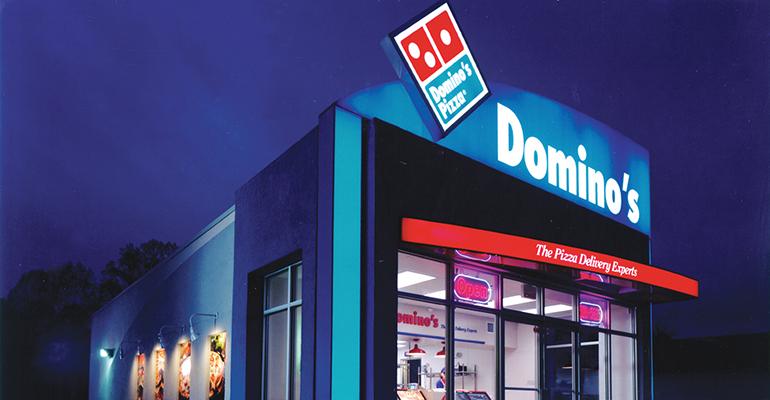Domino’s Pizza Inc.’s same-store sales increased 12.2 percent in the U.S. in the fourth quarter ended Jan. 1, and rose 10.5 percent for the year, the company said on Tuesday, continuing a run of strong sales growth that easily bested any other players in the industry.
Same-store sales over the past three years have increased at a compounded rate of 33 percent. In the fourth quarter, the Ann Arbor, Mich.-based operator’s compounded same-store sales are up 38 percent over the past three years.
“I’m starting to run out of adjectives,” CEO Patrick Doyle said during an earnings call on Tuesday. “So let me say this: Our fourth quarter was remarkable.”
Domino’s domestic same-store sales have increased for 23 straight quarters. Internationally, the chain’s 4.3-percent same-store sales growth was the 92nd straight quarter of growth.
Domino’s same-store sales have increased more than 10 percent on an annual basis in each of the past two years — an unusual rate of performance for a legacy restaurant brand on a sustained run of success.
And Domino’s domestic same-store sales numbers have come during a period in which industrywide same-store sales have weakened. Same-store sales declined an average of nearly 1 percent in the final three months of the year, according to MillerPulse data.
Domino’s said that weakness executives from other chains have reported recently, such as consumer skittishness, calendar changes, weather problems or retail sales declines, haven’t impacted its business.
“We clearly weren’t feeling any of that,” Doyle said.
And the chain’s domestic performance in the quarter was dominant when compared with other pizza players. Papa John’s reported same-store sales growth of 3.8 percent. But Pizza Hut, Papa Murphy’s and Rave Restaurant Group Inc.’s Pizza Inn and Pie Five concepts all recorded declines in the period.
Domino’s run of growth, which started in 2008, and has been nearly uninterrupted since, has come thanks to increases in the use of technology at its restaurants, as well as restaurant remodels and marketing strength.
Digital growth has been particularly notable for the chain, which over the years has expanded its capability beyond mobile phones and to televisions, cars, the Amazon Echo and social media. Its mobile app includes one-touch ordering.
That innovation, and marketing surrounding it, has led to growing consumer adoption. At the end of 2016, 60 percent of Domino’s orders came through digital channels, the company said.
The digital experience is giving Domino’s an advantage that many of its competitors, particularly smaller, regional chains, cannot match.
“Technology is permeating our brand,” said Jeff Lawrence, Domino’s chief financial officer. “Technology is really expensive. But the good news is, technology is really expensive. The other guys just can’t compete.”
The company also saw the benefits of its loyalty program in 2016. Though executives wouldn’t provide details of the program’s impact on the chain’s same-store sales, they did say that it was a “significant” contribute to traffic growth in the period.
Domino’s introduced salads last year, which were aimed specifically at households that might not order pizza because someone in the group wants a salad.
“We’re happy with our salad launch,” Doyle said. “As you can tell from our growth, sales were very good.”
Domino’s same-store sales growth has come without the benefit of limited-time offers and other temporary innovation some chains use to lure customers. That’s deliberate.
“We don’t spend time training on things that are going to go away shortly after we launch them,” Doyle said. “Our view is to do that only for things that are going to have a material impact on our business.”
Domino’s growth in recent years has helped fuel the chain’s further success by giving the company’s franchisees more incentive to build locations.
Operators are more profitable. Domestic franchisees’ profits have increased for eight straight years, Doyle said, and unit-level cash flow now averages nearly $135,000 per year.
So they’re building more locations. Domestic unit count increased by 171 locations, to 5,371 units. Internationally, the company added a record 1,110 locations, and now the chain has 13,811 units globally.
Domino’s is also remodeling. The company expects its “Pizza Theater” remodeling program to be largely completed by the end of the year.
The additional same-store sales and new units are providing more funds for the company’s advertising.
“Our share of voice continues to increase in the pizza category in the U.S.,” Doyle said.
And this is yielding results. Net income at Domino’s increased 15.9 percent in the quarter, to $72.7 million, or $1.48 per share, from $62.8 million, or $1.15 per share the previous year. Revenue increased 10.6 percent, to $819.4 million, from $741.2 million the previous year.
The company’s stock price rose 1.5 percent on Tuesday. Since January 2013, the stock price has more than quadrupled.
Contact Jonathan Maze at [email protected]
Follow him on Twitter: @jonathanmaze





